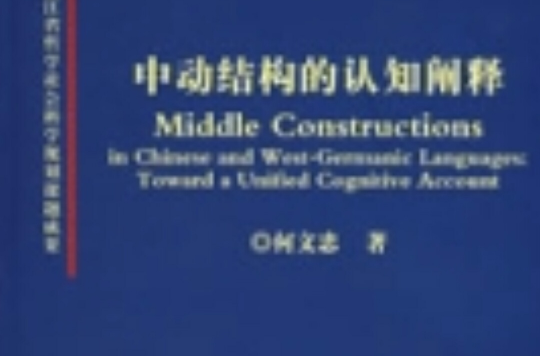《中動結構的認知闡釋》是2007年科學出版社出版的圖書,作者是何文忠。本書對於西日耳曼語和漢語中的中動結構進行了全面的描述,並從認知的角度對中動結構的形成、構句制約及其語義、句法特徵進行了統一的闡釋。
基本介紹
內容提要,編輯推薦,目錄,
內容提要
本論文主要做了以下四個方面的工作。首先,本文確立了漢語非施事主語“起來”結構的中動地位,並對其語義、句法特徵進行了描述和分析。在過去的25年中,中動結構一直是國外語言學界研究的一個熱點問題,其中尤以對歐洲語言的研究最為深入,研究表明中動語義具有跨語言普遍性。相比之下,漢語中動研究卻相對滯後。現有的研究主要是在生成語法框架內進行的。通過用廣為接受的中動語義、句法標準來檢驗漢語非施事主語起來句[NPV起來Adj],我們發現這一結構體現了所有的中動語義,具有跟西日耳曼語中動結構[NPVAdv]相同的語義特徵和相似的句法表征。據此我們確立了其中動地位,這一結構跟西日耳曼語中動結構同屬阿克馬和舒萊默所歸納的類型—中動結構。相對於西日耳曼語的中動結構,漢語中動結構能產性更高,事件的各種被動參與者甚至場景等都可以成為漢語中動結構的主語。其次本文證明了目前流行的對中動結構的分析,如句法說和辭彙說,都存在較大問題,因而是不可行的
編輯推薦
《中動結構的認知闡釋》對中動語義的定義為中動構式用於表達一個被動參與者由於其某種內在或賦予的特性,在促使動詞表達的事件以副詞或副詞性短語表達的方式發生的過程中所起的積極作用。中動是一種恆時性述謂,描述的並不是實際事件的發生,而是虛擬事件的特徵。
目錄
AcknowledgementsAbstractChapter
1 Introduction
1.1 Middle constructions in languages
1.2 The middle construction and middle semantics
1.3 Studies on middles: past and present
1.4 Methodology and procedures
1.5 Goals of this study
1.6 A sketch map of the thesisChapter
2 Characteristics of Middles in West-Germanic Languages
2.1 Semantic classification of middles
2.2 The syntactic features of middles in West-Germanic languages
2.2.1 Passive-participant subject and active morphology
2.2.2 Tense and aspect
2.2.3 Adverbial
2.3 Semantic characteristics of middles in West-Germanic languages
2.3.1 Agent irrelevance and the implicit argument
2.3.2 Time-irrelevance and genericity, non-eventiveness
2.3.3 Passive participant and responsibility of subject,causative modality
2.4 Selectional restrictions on verbs and adverbials in middles.
2.4.1 Middable verbs
2.4.2 Selectional restriction on adverbial
2.5 SummaryChapter
3 The Realization of Middle Semantics in Chinese
3.1 Chinese qilai construction
3.2 A preliminary syntactic analysis of the qilai construction..
3.2.1 Chinese qilai construction is not an elliptical structure..
3.2.2 The struc~ral parsing of qilai construction
3.2.3 Chinese qilai construction is active in morphology
3.3 Middle voice verbs and the middle construction
3.4 The realization of middle semantics in the qilai construction..
3.4.1 The implicit argument and the irrelevance of agent
3.4.2 The realization of non-eventiveness
3.4.3 Modality and responsibility of subject
3.4.4 Genericity
3.4.5 Adverb and adverbial effect
3.5 Restrictions on qilai construction
3.6 The status and function of qilai
3.7 Other issues in middles
3.7.1 對於/就……而言/來說and for-phrase
3.7.2 自己 and oneself in middles
3.8 SummaryChapter
4 Atypical Middles in Chinese and West-Germanic languages
4.1 Syntactic classification of middles
4.2 Adjunct middles in West-Germanic languages
4.2.1 What is adjunct?
4.2.2 The features of adjunct middles
4.3 Adjunct middles in Chinese
4.3.1 Are there adjunct middles in Chinese?
4.3.2 The syntactic and semantic features
4.3.3 Types of adjuncts in the adjunct middles
4.4 The difference between typical and adjunct middles
4.5 Adjunct middles in Topic-prominent Chinese
4.6 Adjunct middles and instrument-subject clauses
4.7 Diverse semantic relations between Chinese verbs and their objects
4.8 Impersonal middles
4.9 SummaryChapter
5 Middles and Tough Constructions
5.1 Two hot topics in the past 25 years
5.2 Chinese nany/construction and English tough construction
5.3 Asymmetry between TC and MC
5.4 A systematic comparison between TC and facility MC
5.4.1 The irrelevance of agent and the implicit argument
5.4.2 Genericity and non-eventiveness
5.4.3 Modality and responsibility of subject
5.4.4 Tough predicates and middle adverb
5.4.5 Aspectual classes of verb and Affectedness constraint
5.4.6 The subject of TCs and MCs
5.4.7 Semantic Compatibility
5.5 SummaryChapter
6 Middles and Syntactically Similar Constructions
6.1 Introduction
6.2 English middles and ergatives
6.3 English middles and intransitive actives
6.4 Middles and transitive actives
6.5 The meaning of the construction
6.6 Other types of qilai constructions
6.7 Other typesof nanyi constructions
6.8 Other types of reflexive constructions in German
6.9 SummaryChapter
7 The Two MF Approaches and Their Problems
7.1 The movement and non-movement approaches to MF
7.2 The main arguments of the Movement Approach
7.3 The dilemma for the Movement Approach to MF
7.3.1 Not every middle construction has its active counterpart
7.3.2 Not every active sentence has middle counterpart
7.3.3 Middles often differ from their active paraphrases in meaning
7.3.4 Restrictions on middle formation are not accounted for
7.3.5 Atypical middles
7.3.6 Impersonal middles
7.4 Major arguments of the lexical approach
7.5 Problems of the lexical approach
7.6 SummaryChapter
8 A Cognitive Approach to Middle Construction
8.1 The need of a new account
8.2 Theoretical framework
8.3 The middle profile
8.4 The construction of meaning and the meaning of construction
8.5 Middle construction and virtual reality
8.6 Events and properties
8.7 Chinese qilai constructions
8.8 Impersonal middles and the reflexive sich in German
8.9 SummaryChapter
9 Conditions on Middle Formation
9.1 The restriction on MF is a notorious question
9.2 The condition on MF
9.2.1 Aspectuality Condition
9.2.2 Responsibility Condition
9.2.3 The interpretive power of the two conditions
9.3 Other factors affecting the acceptability of middles
9.3.1 Semantic compatibility
9.3.2 Pragmatic factors
9.3.3 Asymmetry between ease and difficulty
9.3.4 Ambiguity between active and middle interpretations
9.4 Productivity of middles
9.5 The selection restrictions on MF
9.6 SummaryChapter
10 Integrating the Features of Middles
10.1 Two central properties of middles
10.2 Integrating IA, AM and AE
10.3 Integrating tense, genericity and non-eventiveness
10.4 SummaryChapter
11 Conclusion
11.1 Major findings of this study
11.2 Implications of this study
11.3 Limitations of this study
11.4 Suggestions for further researchReferencesAuthor IndexSubject Index

